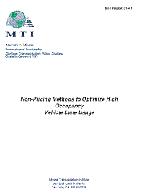- 408-924-7560
- mineta-institute@sjsu.edu
- Donate
Non-Pricing Methods to Optimize High Occupancy Vehicle Lane Usage
The Mineta Transportation Institute) at San José State University conducted this study to review the issues and implications involved in the project in question. Twenty-four potential HOV facility user groups were identified. Through a ranking process, seven of these groups were selected for further study in phase one. The project team made the following preliminary conclusions as to the suitability of each group to use HOV facilities and recommended whether each group should be included in the phase two study to refine these findings and develop implementation strategies.
1. As the result of 1998 legislation, which includes sunset provisions, electric vehicles and other ILEVs, ULEVs, and SULEVs have recently been included in users of HOV facilities. This legislation should be reviewed in phase two to determine if the sunset provisions should be extended.
2. The identified negatives for including light delivery trucks outweigh any identified positives. Unless new evidence surfaces, this group should be dropped from the study.
3. Radio dispatched vehicles are strong candidates, inclusion should result in improved public transportation services. Phase two study of possible enabling legislation should consider sunset provisions to encourage future fleet conversion to vehicles using alternative fuels.
4. Inclusion of EPA certified high mileage vehicles and vehicles using alternative fuels could encourage use of these vehicles with beneficial impacts on air quality and fuel consumption. Possible significant problems of capacity, identification of users, and police monitoring and enforcement should be studied in phase two.
5. Deadheading transit and charter buses appear to be worthy candidates and should be studied further. School buses, because of inherent problems, should not be considered unless significant warrants surface.
6. There does not appear to be any advantage in including light service trucks (utility, maintenance, etc.).
7. There is no compelling reason to change existing conditions regarding enforcement and emergency vehicles.
GEORGE E. GRAY
Principal Investigator George E. Gray is a transportation consultant, and holds a BS degree in civil engineering from Stanford University, an MPA from California State University , San Diego, and an ME in Engineering from the University of California at Davis. He has worked on several MTI publications, including Impacts of the North American Free Trade Agreement, and NAFTA II: California Border Zone Land Transportation Issues. He is a member of the Transportation Research Board and is a life member of the American Society of Civil Engineers. Mr. Gray has been published in numerous periodicals, and has presented papers at many conferences and symposia.
-
Contact Us
SJSU Research Foundation 210 N. 4th Street, 4th Floor, San Jose, CA 95112 Phone: 408-924-7560 Email: mineta-institute@sjsu.edu






